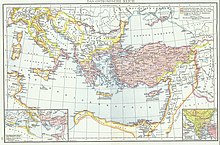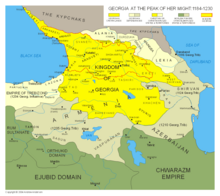Zichi

The Zichi , other forms of the name Zygi (i) , Zygoi , Zekchi , Georgian Jiqi (plural: Jiqebi ), German also Sichen , were a historical, ancient and medieval tribal association on what is now the Russian Black Sea coast, between the western foothills of the Caucasus and the northeast coast of the Black Sea . They were from the 1st century BC. Chr. ( Strabo ) until the 15th century AD repeatedly mentioned and described in historical sources . Their settlement area, Greek Zyx ( Zych ) or Zekchia , Italian also called Sychia , Georgian Jiqeti , according to these sources, was initially somewhere between today's Gagra and Tuapse and later, perhaps with Roman - Byzantine help, expanded into the area of the mouth of the Kuban into the Neighborhood of historic Tmutarakan . Perhaps it was temporarily under Byzantine suzerainty, and in the Middle Ages the south was also temporarily under Georgian suzerainty.
Tradition and way of life
Lore and archaeological studies have shown that the Zichischen tribes were sedentary farmers and fruit growers, for which the subtropical coast was well suited. In addition, livestock breeding played a major role, probably already connected with the semi-nomadic lifestyle typical of the entire Greater Caucasus : most of the mountain residents moved their herds of cattle to lower altitudes in the snowy winter, some residents of the foreland to the mountains in midsummer. Because Georgian sources repeatedly report that Jiqi warriors appeared in their ranks as mounted elite warriors, horse breeding also played a role, which archaeologically researched horse burials also suggest. Strabo already reports of intensive fishing in the Black Sea, but also of piracy . He also describes the custom of taking prisoners for ransom in the event of a conflict. The Mediterranean slave market has been supplied with prisoners who have not been released since Roman antiquity. The custom is reported repeatedly from the Greater Caucasus up to the beginning of the 19th century. In addition, chic traders and townspeople in the neighboring towns around the Cimmerian Bosporus are described (including Cherson and Tmutarakan), Emperor Constantine VII. Porphyrogennetus mentions the trading town of Nikopsis in Zekchia .
Politically, the Zichischen tribes were probably led by initially independent tribal kings or chiefs. From an unspecified point in time, perhaps as early as the 7th century AD, the Byzantine Empire made efforts to bring the coast under its control. Emperor Manuel I also bore the title "Emperor of Zichia, Chasaria and Gothia " and there is a seal from the late 11th century that designated a certain Michael as " Archon of Tmutarakan, Zichia and Chasaria". It is unclear, however, whether it was a question of direct rule, loose suzerainty or a formal claim and whether the balance of power changed. At the same time, the medieval Kingdom of Georgia established itself in the 9th / 10th. Century in southern Jiqeti. Because Georgian sources also mention some Zichische tribal leaders, this rule could also have been an indirect suzerainty, at least for a time. After the Fourth Crusade , the Byzantine influence in the 13./14. Century replaced by the influence of the Genoese colonies , which in turn with the Ottoman expansion in the 14th / 15th centuries . Gradually disappeared from the Black Sea region in the 19th century. Georgian influence in the south ended with the final disintegration of unified Georgia in the second half of the 15th century.
religion

Prokopios of Caesarea reports the legend that the apostle Andrew also visited Zichia after his visit to Abasgia ( Abkhazia ). Byzantine Orthodox proselytizing began around the 7th century, which is why the Byzantine establishment is believed to have begun , followed by Georgian Orthodox since the 9th century and, with the establishment of the Genoese colonies in the 13th century, Roman Catholic missionary efforts . The bishops of the various churches were in sharp competition with one another. After the Mongol campaigns and the war campaigns of Timur , contact with the mother churches was broken and the dioceses disappeared. Some church ruins in the region have been preserved from this period. Although the Christian missionaries among the Zichi were more far-reaching than z. B. in the east and north neighboring Kerketen , archaeological studies show that pre-Christian religious rituals were never suppressed, after the disappearance of the church organizations they dominated the religious rituals of the inhabitants of the region along with some Christian relics.
History and classification
The Zichi initially lived in a small settlement area between today's Gagra and Tuapse and, perhaps with Roman-Byzantine help, spread in the 3rd-8th centuries. Century north to about Gelendzhik , whereby the older tribes of the Acheans and Tetraxites (an eastern splinter group of the Crimean Goths ) and probably also some older tribes of the Mayots were displaced or assimilated.
The language of the Zichi has not survived, and they themselves did not leave any written evidence. Research suggests that they used language forms from the Northwest Caucasian language family . This is supported by the Northwest Caucasian water names that dominate the region and other geographical names and the traditional names of the tribal kings. The archaeologically seamless transition from the Zichi and Kerketen , whose names from the sources were replaced by the names of the Circassian tribes after the campaigns of Timur at the beginning of the 15th century , confirms this view. Archaeologically, a temporary retreat of parts of the population into the mountains can be ascertained, but no fundamental change in the population. Not only the Genoese traveler Giorgio Interiano of the 15th century calls the tribes he describes as Zichi, chiamati Ciarcassi (Zichi, called Circassians), Arabic sources also equate them by referring to the first Burji Mamluks as Zichi, later as Circassians . That is why experts count the Zichi and Kerketen as part of Circassian history or prehistory. Whether in the 14./15. There were internal political changes at all in the 19th century or there was only a change in foreign names, is difficult to determine due to a lack of precise sources.
Which Northwest Caucasian language form the Zichi spoke is the subject of hypotheses. Some researchers suspect that they spoke early forms of Ubykh and point to the similarity of the Georgian name to the name of a later Ubych group, the Jigit / Jiget. Other researchers point out that they suddenly appeared in the first century, suggesting that they might have immigrated from Alan territory and perhaps spoke Iranian before later adopting Northwest Caucasian languages. They refer to the similarity of the name of the Zygii with the name of a high-ranking group of the Sarmatian tribes " Ja-zygii ". Still other researchers see their immigration from the east as well, but believe that they may have originally spoken Northeast Caucasian languages before adopting Northwest Caucasian language forms. Ultimately, all of these hypotheses are very speculative and individual name similarities are not sufficient evidence. Whatever the linguistic situation of the Zichi, it is undisputed that, like the Kerketes, they were forerunners of the Circassians.
literature
- Zichia in: ODB , New York 1991, Vol. 3, pp. 2226-2227.
- Zikhi article in the Great Soviet Encyclopedia (English translation).
- Nadir I. Natho: Circassian History. Xlibris, New York NY 2009, ISBN 978-1-4415-2389-1 .
Footnotes
- ↑ Geographika XI 2.12 and the following paragraph (English translation).
- ↑ See ODB article. Text passage in Constantine VII. De Administrando Imperio 42.95-99.
- ↑ ODB article.
- ↑ ODB article: Prokop, Historien 8,4,2.
- ↑ Johannes Preiser-Kapeller : Between Constantinople and the Golden Horde: The Byzantine church provinces of the Alans and Zichen in the Mongolian sphere of influence in the 13th and 14th centuries. in: Jürgen Tubach (Ed.): Caucasus during the Mongol Period. Wiesbaden 2012, pp. 199-216.
- ^ Kadir I. Natho p. 59
- ^ Text of the reports by Interiano (Italian).
- ↑ E.g. the Kaukasiologist Leonid Ivanovich Lavrov quoted in the ODB: Adygi v rannem srednevekov'e. (= The Circassians in the Early Middle Ages) in: Sbornik statej po istorii Kabardy. (= Anthology of the essays on the history of Kabarda) Nalchik 1955.
- ↑ Kadir I. Natho p. 60ff.
- ↑ Kadir I. Natho pp. 59–61, Natho cites the hypotheses of the researchers S. Khotko and George Kissling.
- ↑ E.g. Amjad M. Jaimoukha: The Circassians. A Handbook p. 42 ff.


